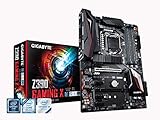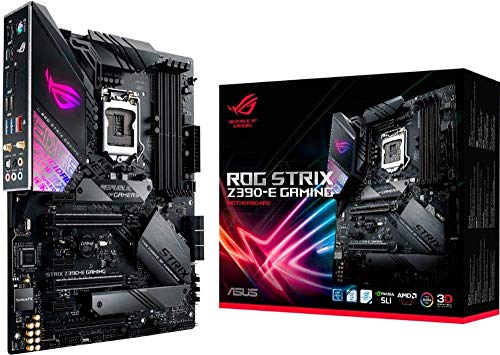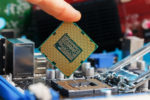Best Motherboard for i7 8700k: Complete Reviews With Comparisons

You might want to hold on to your Intel Core i7 8700k processor when upgrading PC components.
Even today, it still remains one of the best Coffee Lake processors that doesn’t break the bank.
Instead of buying a more expensive processor, getting the best motherboards for i7 8700k can take its features to even greater heights.
With so many motherboards to choose from, we’ll give you an effortless search by narrowing the pool down to five quality options.
For this shortlist, we have chosen one Q370 motherboard along with four Z390 chipset boards.
Comparison Chart
Motherboard for i7 8700k Reviews
1. MSI MPG Z390 Gaming Edge AC Motherboard
The MPG Z390 Gaming Edge AC is a mid-range motherboard from MSI.
It provides the needs of many PC builders at a very reasonable price, and it doesn’t fail to deliver aesthetic features.
Review
The MSI MPG Z390 Gaming Edge AC motherboard supports 9th and 8th Generation Intel Core processors, including the Intel Core i7 8700k.
It is a good-looking motherboard with salient design features that emphasize the heatsinks.
This board offers a lightning-fast gaming experience with its memory, storage interface, and connectivity options.
ALSO READ:
Motherboard for i7 9700K
- Memory Slots
Four DDR4 DIMM slots line the right side of the CPU socket to support a maximum of 128GB RAM.
These memory module slots run on dual-channel mode, and they support non-ECC unbuffered memory modules and XMP modules.
- Expansion Slots
For expansion options, the MSI MPG Z390 Gaming Edge AC motherboard has three PCIe 3.0 x16 slots.
These three slots can run on either x16/x0/x4 or x8/x8/x4 modes.
Additionally, the board has three x1 PCIe 3.0 slots for smaller adapters.
The primary x16 expansion slots allow multi-graphics functionalities using the 2-Way NVIDIA SLI and 3-Way AMD CrossFire technologies.
- Storage Interface
The MSI MPG Z390 Gaming Edge AC has six SATA 6Gb/s ports and two M.2 slots for mixing and matching storage components.
While the SATA ports support RAID 0, 1, 5, and 10, the M.2 ports can also support RAID 0 and 1 for PCIe storage devices.
The M.2 slots can support PCIe 3.0 x4 and SATA 6Gb/s connections, but they share bandwidth with all the SATA ports.
Furthermore, the M.2 slots allow the use of high-speed Intel Optane Memory modules.
Drivers and BIOS should be in their latest versions before the installation of any Intel Optane device.
- Options for System Cooling
The MPG Z390 Gaming Edge AC uses a 10+1 phase VRM, achievable by doubling the four CPU drivers’ power stage components.
Additionally, the board offers several options for peripheral cooling. It has a CPU fan connector, a water pump connector, and five system fan headers.
With the VRMs coupled with massive heatsinks and more than adequate cooling connectors, heat dissipation shouldn’t be a problem during high-performance situations.
- Connectivity and Other Features
The MSI MPG Z390 Gaming Edge AC allows seamless connectivity through LAN, Wi-Fi, and Bluetooth.
It comes equipped with an Intel I219-V Gigabit LAN controller and an Intel Wireless-AC 9462 module.
It also has two RGB headers, one RAINBOW LED connector, and a unique CORSAIR header for onboard aesthetics.
For audio, the board uses a Realtek ALC1220P Codec with 7.1 channels of HD sound, and it sports a S/PDIF out port.
The rear panel has two USB 3.1 Gen1 ports, one USB 3.1 Gen2 Type-A, and one Type-C.
You will also find a PS/2 combo port, two USB 2.0 ports, a DisplayPort, and an HDMI.
Internal connections allow additional USB ports through the front panel connectors.
Finally, you will find extra features, including a TPM connector, a chassis intrusion connector, and a Thunderbolt AIC header.
PROS
CONS
2. Gigabyte Z390 Gaming X Motherboard
The Gigabyte Z390 Gaming X motherboard has become a requirement for those who want to overclock the latest Coffee Lake processors without spending too much.
Although it carries excellent overclocking capabilities, it is a very affordable motherboard.
Many enthusiasts exploit its price point with the i9 9900k processor.
Review
Since it works well with the i9 9900k, the Gigabyte Z390 Gaming X motherboard will work lighter loads when overclocking with the i7 8700k Intel Core processor.
If you do not need an SLI design, this motherboard can replace the pricier Gigabyte Z390 SLI boards.
- Memory Slots
The Gigabyte Z390 Gaming X motherboard has four DDR4 DIMM sockets that can support 128GB max.
Depending on the CPU installed, these sockets can overclock up to 4266Mhz using dual-channel memory.
The memory sockets support non-ECC UDIMMs and XMP modules, but they also run ECC modules in non-ECC mode.
- Expansion Slots
For expansion options, the Gigabyte Z390 Gaming X has two PCIe 3.0 x16 sockets, one running at x16 and the other at x4.
You can connect smaller adapters through the four PCIe 3.0 x1 sockets.
These expansion slots allow multi-GPU support for AMD Quad-GPU CrossFire and 2-Way AMD CrossFire technologies.
- Storage Interface
The Gigabyte Z390 Gaming X has six SATA 6Gb/s connectors, all supporting RAID 0, 1, 5, and 10 for variable storage setups.
Two M.2 slots allow PCIe x4 or x2 SSD storage connections.
The first M.2 slot is an M2M, which can run simultaneously with all the SATA ports. The second one is an M2A, which disables both the fifth and sixth SATA ports.
While you have the option to install SSDs, traditional hard drives can also work at better speeds with Intel Optane Memory modules.
- Options for System Cooling
The Gigabyte Z390 Gaming X system uses 10+2 phases of digital VRMs with its massive heatsinks.
For cooling accessories, the board only has a CPU fan header and three system fan connectors.
These connectors may not be enough, especially during overclocking operations.
- Connectivity and Other Features
This motherboard has an Intel Gigabit Ethernet LAN chip. However, it does not include a wireless module for Wi-Fi and Bluetooth.
Aside from having an attractive board design, it only has a single, non-addressable RGB header.
It gets better in the audio department, though, with a 7.1-channel HD Realtek ALC892 codec and support for S/PDIF.
Back panel connectors include a PS/s, an HDMI, one USB 3.1 Gen2, five USB 3.1 Gen1, and two USB 2.0.
More USB connections are available for the front panel through the internal connectors.
Extra features include a TPM connector, a Clear CMOS jumper, and a Thunderbolt AIC header.
PROS
CONS
3. Gigabyte Z390 I Aorus Pro Wi-Fi Motherboard
Gigabyte has a reputation for manufacturing high-quality Mini-ITX motherboards.
It brings this reputation even further by creating a Mini-ITX board under the Aorus brand.
When looking for a Mini-ITX board for the i7 8700K, the Z390 I Aorus Pro is a better board than the MSI MPG Z390I Gaming Edge AC.
Review
If you plan to build a small high-performance PC rig with the Intel Core i7 8700K processor, the Gigabyte Z390 I Aorus Pro Wi-Fi motherboard is up to the task.
It may be compact, but it packs plenty of serious features.
Most importantly, you won’t have to worry about upgrading from the Intel Core i7 8700K processor, as it can also support the i9 9900K.
- Memory Slots
Among all the options here, the Gigabyte Z390 I Aorus Pro Wi-Fi has the least DIMM slots.
Its small size only allows it to sport two DDR4 slots, each allowing a 32GB module for a total RAM capacity of 64GB.
Although it may be fewer than those on other boards here, its dual-channel memory architecture allows RAM overclocking up to 4400MHz depending on the CPU.
These memory slots only support non-ECC UDIMM and XMP modules. ECC UDIMMs will operate in non-ECC mode.
- Expansion Slots
Another setback for this smaller board is the lack of expansion options.
It only has a single PCIe 3.0 x16 slot, which is enough for a reliable graphics card.
However, it lacks a secondary multiple-lane PCIe socket that should enable multi-graphics options.
You will find an M.2 socket connector, but it will only support the included wireless module.
- Storage Interface
While the Gigabyte Z390 I Aorus Pro Wi-Fi has minimal venues for component population, it sports four SATA 6Gb/s slots and two M.2 sockets for SSDs M2M and M2P.
The M2P M.2 slot will disable some SATA functionality.
The SATA slots allow RAID 0, 1, 5, and 10, and the M.2 sockets accept Intel Optane Memory modules.
- Options for System Cooling
The 6-phase VRM solution should be enough for this small Mini-ITX board with its enormous heatsinks.
Moreover, a CPU fan header and two system fan connectors should be enough to deliver airflow throughout the small board.
- Connectivity and Other Features
Albeit smaller than the Z390 Gaming X, the Gigabyte Z390 I Aorus Pro Wi-Fi offers Wi-Fi and Bluetooth on top of Ethernet connectivity.
It uses an Intel GbE LAN chip and an Intel CNVi interface Wi-Fi 802.11.
Furthermore, the board provides better aesthetic lighting and audio options than the Z390 Gaming X.
It sports a Realtek ALC1220-VB codec with SDS and S/PDIF support, and it has a digital LED strip header, a power-select jumper, and an RGB LED connector.
Back panel connectors include a USB Type-C, five USB 3.1 ports, an HDMI, and a DisplayPort.
Additionally, the internal connectors enable TPM, Clear CMOS, chassis intrusion warnings, and additional front panel USBs.
PROS
CONS
4. Asus Prime Q370M-C CSM Business Motherboard
Asus is the world’s biggest motherboard brand, responsible for creating high-end products for various applications.
The Asus Prime Q370M-C/CSM sits on a different platform than the Z390 chipset motherboards.
While many high-quality motherboards have extensive features revolving around competitive gaming, computers also need to make a stand in the corporate setting.
Review
The Prime Q370M-C/CSM is a business motherboard that offers features for security, stability, and effortless manageability.
It can bring your business to a whole new level by providing enhanced features for smooth IT operations.
You can deploy this motherboard for all of your business needs, as it can provide comprehensive system protection, 24/7 reliability, and customizable management features.
This motherboard comes with the Asus Control Center, a server-grade IT management software from the Asus Corporate Stable Model (CSM).
- Memory Slots
The Asus Prime Q370M-C/CSM has four DDR4 DIMM slots, but each can only carry 16GB modules for a maximum RAM capacity of 64GB.
While it does not use a dual-channel memory architecture, you can randomize memory settings using Intel XMP.
- Expansion Slots
The expansion slots on the Asus Prime Q370M-C/CSM motherboard include a PCIe 3.0 x16, two PCIe 3.0 x2, and one PCI.
The x16 slot allows you to attach a high-performing graphics card, while the smaller slots let you add better video, sound, and networking capabilities.
- Storage Interface
The Asus Prime Q370M-C/CSM reduces memory and expansion options like the Z390 I Aorus Pro Wi-Fi. Still, it does not hold back on storage options.
It has six SATA 6Gb/s ports supporting RAID 0, 1, 5, and 10, and two Intel Optane Memory Ready M.2 sockets.
One M.2 socket supports both SATA and PCIe mode, while the other only uses PCIe.
- Options for System Cooling
Upon studying the Prime Q370M-C/CSM board for the first time, you will notice it does not have the massive heatsinks and VRMs present in gaming-intensive motherboards.
This board shifts focus from extensive cooling to exceptional-grade security.
Nevertheless, you will still find a basic CPU fan connector and two system fan headers for adequate cooling.
- Connectivity and Other Features
The Prime Q370M-C/CSM has an Intel I219LM Gigabit LAN controller for Ethernet, but it does not have a wireless module.
Note that internal connections include an M.2 slot for Wi-Fi and Bluetooth devices.
If you look at the board’s design, you will find that it purely means business. It is quite plain, does not have any attractive colors, and lacks RGB lighting.
The best features of the Prime Q370M-C/CSM include several legacy ports that still offer convenience in an office setting.
It has an LPT header, a COM port, PS/2 ports, a D-Sub, a DisplayPort, an HDMI, and some audio jacks.
PROS
CONS
5. Asus ROG Strix Z390-E Gaming Motherboard
In any motherboard comparison looking at a whole stretch of features, any of the ROG Strix boards can outshine its competitors.
We often associate Asus and the Republic of Gamers (ROG) with high-end, pro-grade hardware directed towards enthusiasts and competitive eSports gamers.
The Asus ROG Strix Z390-E Gaming motherboard is jam-packed with top-tier components that can easily set it apart from other Z390 chipset boards.
Review
The Z390 chipset motherboards hit the shelves with the primary purpose of adding better connectivity than the Z370 chipset.
With the Asus ROG Strix Z390-E Gaming motherboard, those features are just a small part of its provisions.
However, this wide array of features comes with a hefty price tag for some budget-oriented PC builders.
Component ratings that soar across the board only justify its price point and enforce the ROG Strix brand reputation.
RELATED:
Motherboard for i7 4790k (Guide)
- Memory Slots
The Asus ROG Strix Z390-E Gaming board has four DDR4 DIMM slots.
While it uses a dual-channel memory architecture, it can only hold a maximum of 64GB non-ECC UDIMMs.
These memory slots support Intel XMP customization.
- Expansion Slots
The Asus ROG Strix Z390-E Gaming has very similar options for expansion as the MPG Z390 Gaming Edge AC.
It sports three x16 PCIe 3.0 slots, two running at x16 or dual x8 and one running at x4 max.
Additionally, it has three PCIe 3.0 x1 slots for other expansion cards.
With the multiple x16 slots, you can enable multi-GPU support for NVIDIA 2-Way SLI and AMD 3-Way CrossFireX technologies.
- Storage Interface
Storage options are also very similar to those of the MPG Z390 Gaming Edge AC.
Choose from six SATA 6Gb/s (with RAID 0, 1, 5, and 10) and two M.2 slots (one with SATA, PCIe, and Intel Optane Memory support, and the other with PCIe).
- Options for System Cooling
The Asus ROG Strix Z390-E Gaming board offers comprehensive cooling options.
It has dual onboard M.2 heatsinks, a water-pump header, a MOS fan with bracket, a fan extension header, a CPU fan connector, a CPU OPT fan, and a thermal sensor header.
- Connectivity and Other Features
For connectivity, the Asus ROG Strix Z390-E Gaming board sports the Intel I219V with Anti-surge LANGuard and ROG GameFirst Technology.
It also has an Intel Wireless-AC 9560, providing Wi-Fi and Bluetooth for the best wireless experience.
This board provides the best audio experience among all of the choices here.
It has a ROG SupremeFX8-Channel HD audio with dual headphone amplifiers, shielding technology, high-quality playback, and multi-streaming.
As for other internal and back panel connectors, the Asus ROG Strix Z390-E Gaming boasts many extras for aesthetics and other functions except for legacy ports.
PROS
CONS
Which Motherboard Is Best for i7 8700k?
Among the choices, we recommend the MSI MPG Z390 Gaming Edge AC as the top motherboard for i7 8700k.
At only about half the price of the Asus ROG Strix Z390-E Gaming board, it packs plenty of features that any gamer will love.
It also provides a sensible layout, aesthetic features, 802.11ac support, and exceptional performance, all while having a very budget-friendly price tag.
If you are not satisfied with this shortlist, you can choose from other Z390 or B360 boards.
You can also opt for the slightly cheaper Z370 chipset motherboards, but they do not have enough high-speed USBs, and they don’t offer integrated Wi-Fi.














